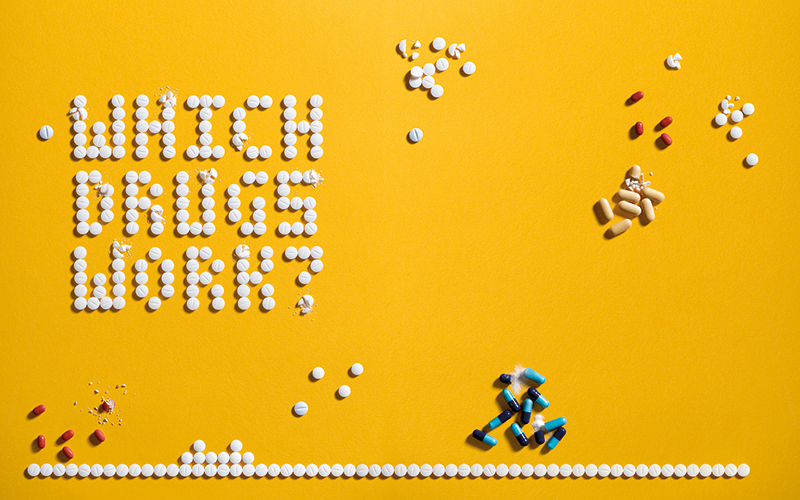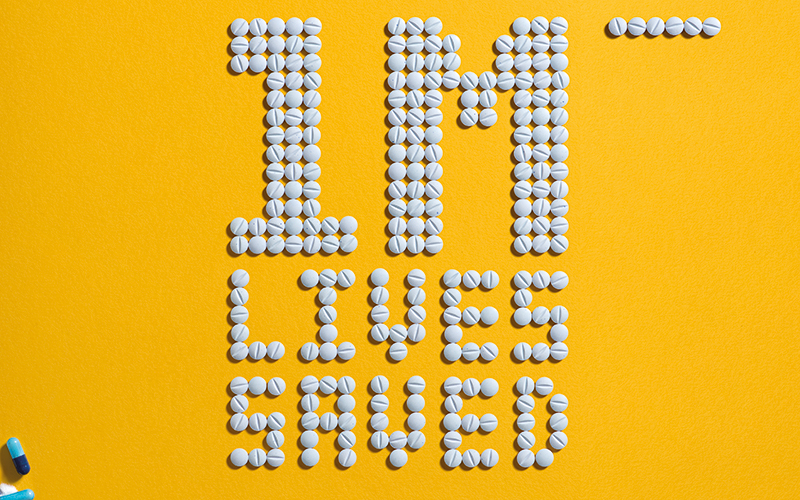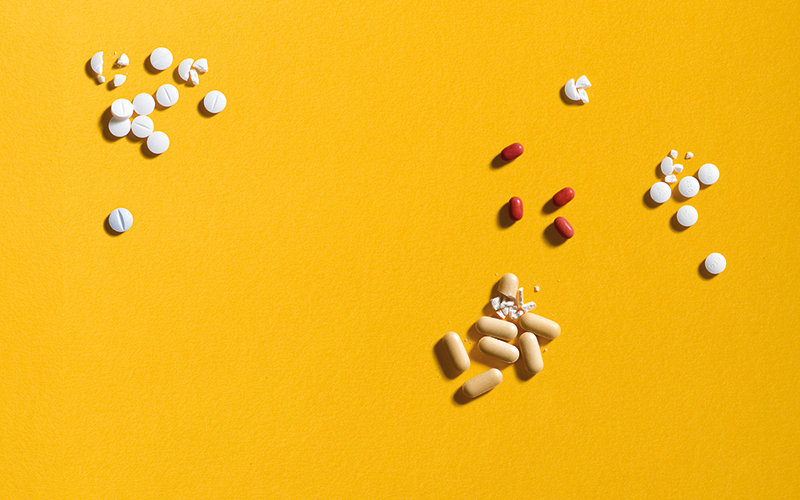The story of a pioneering randomised trial that was launched at speed and has saved well over a million lives through identifying which medicines helped in the fight against COVID-19 and which were of no clinical benefit.

Few medical investigations can have been conceived and mobilised as quickly as the RECOVERY (Randomised Evaluation of COVID-19 Therapy) Trial, which has just celebrated the second anniversary of its quick-fire launch in March 2020.
In the weeks leading up to that launch, as news of a new and rampant virus began to emerge from China and South Korea, the notion of instigating a randomised trial for existing approved medicines was forming in the mind of Martin Landray, Professor of Medicine and Epidemiology at Oxford Population Health, University of Oxford.
“I’d been running clinical trials for heart and kidney disease and a few others for 20 odd years, but never for an infectious disease,” he says. By late February 2020, the global momentum of COVID was unstoppable. “I wrote to Jeremy Farrer, Director at the Wellcome Trust, saying that we are going to want to start using treatments for the virus, and if we’re not careful large quantities of drugs will be thrown at patients and we’ll never know if they do any good or not. Is anybody thinking about using randomised trials, because they would give a robust and rapid assessment of what works and what doesn’t?”
Farrer suggested that Landray speak with Peter Horby, Professor of Emerging Infectious Disease, also at the University of Oxford. “We had spoken to each other for a grand total of probably 20 minutes on three occasions,” says Landray. Horby’s work had been focused on infectious outbreaks overseas, including SARS, MERS, and Ebola.
This partnership of Landray and Horby laid the foundations of the RECOVERY Trial.
Time was against them, though. This struck Farrer and Landray with some force as they travelled together on a bus from Marylebone to Euston Square, home of the Wellcome Trust. “We compared notes and it dawned on us that the UK was going to be in a similar position to northern Italy within about two weeks. The tsunami was coming and if we were to have a clinical trial, it had to be up and running before it arrived. Once that tsunami hit the UK hospitals, they were going to be overwhelmed.”
With not a minute to waste, Landray and Horby, now joint chief investigators, wrote the trial protocol on 10 March 2020. Chris Whitty, the Chief Medical Officer, gave them his backing. Approvals from the MHRA, REC and HRA followed swiftly and the funding fell into place.
Reaching out
Amid this whirlwind of activity, an administration team was coming into being at the University of Oxford. One of the first recruits was Richard Haynes, Professor of Renal Medicine and Clinical Trials at the Nuffield Department of Population and Health, who was to become the Clinical Coordinator. “We needed trial managers, computer programmers, computer testers, statisticians, data managers, communications people,” he says. “I walked around the department asking people, ‘what are you doing for the next few weeks?’.”
Haynes’ role was to ensure everybody knew what everybody else was doing, and to manage the process of reaching out to the hospitals. “We had excellent help from NIHR and its clinical research network. I said we needed doctors who were willing to be the principal investigators and take responsibility for the trial in each hospital. Infectious diseases experts, intensive care doctors, respiratory doctors. They came up with all the names.” The chief medical officers smoothed the approach by writing to every hospital in the UK asking them to adopt the trial as part of their normal clinical care for COVID patients.
“The tsunami was coming and if we were to have a clinical trial, it had to be up and running before it arrived”
The next task was to sign up the patients. Haynes and a colleague made a training video, playing the role of doctor and patient, to show hospital clinicians how to take consent. “It was uncomfortable, but our goal was serious. We needed hospitals to be ready before the huge number of cases hit. Once they were overwhelmed, they wouldn’t be able to take on anything other than keeping themselves afloat.”
It worked. The first patient was enrolled on 19 March, just nine days after the protocol was written. “With most trials, getting that first patient in a year or 18 months would be normal. Two weeks was staggering,” says Haynes. By 4 May the number had soared to 10,000. Just as remarkable, only a month later, on 5 June 2020, the first results were ready.
Which medicines
But what criteria had been applied to select the pre-approved medicines that RECOVERY would test? “We had four,” says Landray. “The first was there had to be some plausible reason that this treatment might work. The second was that we had to know enough about its safety. The
third, that there had to be enough of the drug to be able to study in a trial of several thousand people looking at the impact on mortality. The final criterion was that if we got a clear result, the drug could be rapidly made available not only across the UK but around the world.”
For the clinicians and nurses on the frontline, the process was kept as simple as possible. They had to do little more than prescribe the tested drug and administer it as part of the normal care process. In the background, the Oxford team managed the IT, ensuring that each recruited patient was linked to their central NHS records, so that outcomes could be tracked long-term.
The first drug to come under the scrutiny was hydroxychloroquine (see box, below). Normally used to treat malaria, it attracted enormous hope in the early days of the pandemic.
A few countries, including the US, officially recommended hydroxychloroquine for COVID patients. President Trump was a loud proponent. When the RECOVERY results came back in June, the disappointment was palpable – it showed no clinical benefit.
The breakthrough
Next came the run-of-the-mill steroid dexamethasone. Its anti-inflammatory properties could suppress the immune system, which caused a number of experts to caution vociferously against using it. The RECOVERY team countered that there was enough uncertainty and perhaps suppressing the immune system might be a good thing. “Peter and I saw the results about a week before publication,” says Landray. “We had the statisticians try every which way to make sure that we couldn’t break them, because we knew that these results were going to be game changing.”
On 16 June 2020, just three months after the trial started, Landray and Horby announced that dexamethasone reduced deaths among the most severely ill patients by a third. It was the first clear breakthrough in the global response to COVID and a clear vindication of the RECOVERY Trial. “We announced the results at lunchtime, it became policy by tea time, and was saving lives by the weekend,” says Landray. Haynes adds: “Nobody had imagined how well dexamethasone would work. It was a big boost for us, proving that randomising was appropriate, and a huge boost for the hospitals and all their staff.”
Dexamethasone’s other great advantages were its abundance and low cost. “It could be adopted widely, which was vital given the scale of the pandemic and the repeated waves,” says Landray.
It is now thought to have saved more than a million lives since the start of the pandemic (see box, below).
In the months that followed more medicines were tested: lopinavir-ritonavir, an antiviral used to treat HIV, and azithromycin, an antibiotic with anti-inflammatory properties. Neither showed any beneficial effect. All the same, these were useful results. “I’ve done trials in the past and frequently had negative results,” says Haynes. “It is disappointing, but you learn a lot from negative trials – that we shouldn’t be trying to give people certain drugs.”
As the trial moved into 2021, convalescent plasma, blood rich with antibodies, colchicine, an anti-inflammatory used to treat gout, and aspirin all proved to be ineffective. But positives also came to light. Tocilizumab and baricitinib, both anti-inflammatories that treat rheumatoid arthritis, and the monoclonal antibody combination of casirivimab and imdevimab, all significantly reduced deaths among patients hospitalised with COVID.
Hydroxychloroquine and convalescent plasma: early promise fades
In the early days of the pandemic, two of the approved drugs suggested for repurposing to treat COVID were chloroquine and hydroxychloroquine, anti-malarials sometimes also used for autoimmune conditions. A number of countries, including China, South Korea and Italy recommended the use of chloroquine, while Donald Trump’s enthusiasm for hydroxychloroquine sparked a surge in demand for the drug.
RECOVERY gave the drug to a randomised group of 1542 patients and compared them with a second randomised group of 3132 patients receiving just usual care. It found no significant difference in the primary endpoint of 28-day mortality of 25.7% for hydroxychloroquine versus 23.5% for usual care. Nor did it find any evidence of beneficial effects on the length of the hospital stay or other outcomes. Another potential treatment with promise was convalescent plasma – blood taken from people who have recovered from an infection and so contains the antibodies needed to fight it off. Convalescent plasma was being widely used to treat COVID patients when in May 2020 the RECOVERY Trial began to test it. In January 2021, RECOVERY reported its initial results: looking at, it found no significant difference in the primary endpoint of 28-day mortality – 18% for convalescent plasma and the same for usual care alone.
Breaking down barriers
Plaudits for the team began to accumulate. Amid the industry awards and prizes that came their way in 2021, Landray and Horby were knighted and Haynes was given an MBE. RECOVERY International was also launched, initially to Indonesia and Nepal, then Vietnam, South Africa and Ghana. As it marked its second anniversary, the RECOVERY Trial had enrolled more than 47,000 patients from almost 200 hospitals in the UK and around the world.
COVID hasn’t gone away and the trial continues to test suitable drugs. Looking back on how much it has achieved in so little time, how might RECOVERY have altered the research landscape? “Research can and should be part of the day-to-day business of the NHS,” says Haynes. “I see patients when I’m on the wards and I sometimes get a nagging feeling a lot of stuff that we do in medicine is probably pointless or maybe worse. We need more trials, and they should not be the preserve of academics at the end of a dark corridor where normal people never go. We should be breaking down the barriers.”
Landray agrees: “I think that we have demonstrated that randomised trials don’t have to cost billions and don’t have to be difficult. The places to do these are where real patients meet real doctors in real clinical circumstances. We can do these trials and get clear results. For example, the burden of heart disease, common cancer, depression, dementia and arthritis is enormous, and while there have obviously been good trials in a number of those areas, the opportunities to evaluate more treatments is huge.”
RECOVERY timeline

10 March 2020: first draft protocol written
19 March 2020: first patient enrolled
4 May 2020: 10,000 patients enrolled
5 June 2020: hydroxychloroquine gives no clinical benefit
16 June 2020: dexamethasone reduces deaths by one-third in sickest patients
29 June 2020: lopinavir-ritonavir gives no clinical benefit
14 December 2020: azithromycin found to be ineffective
15 January 2021: convalescent plasma gives no clinical benefit
11 February 2021: corticosteroids with tocilizumab reduces deaths by up to a half
18 February 2021: RECOVERY International launches
5 March 2021: colchicine found to be ineffective
8 June 2021: aspirin found to be ineffective
16 June 2021: monoclonal antibody combination reduces deaths in people unable to mount their own immune response
3 March 2022: baricitinib reduces deaths by one-fifth
Dexamethasone: worldwide life-saver
The first great success story to emerge from the RECOVERY Trial was the discovery of the steroid dexamethasone as a viable treatment for COVID patients. Inexpensive, widely available and easy to administer, dexamethasone is normally prescribed for a range of inflammatory and autoimmune conditions.
For the trial, a randomised group of 2104 patients were given 6 mg of dexamethasone once a day for 10 days and compared with a second randomised group of 4321 patients who received just the usual care. Among this second group, 28-day mortality was highest for those placed on ventilation (41%), intermediate for those who needed oxygen only (25%), and lowest for those who required no respiratory intervention (13%). Among the first group, dexamethasone was found to reduce deaths in ventilated patients by one-third and in patients receiving oxygen only by one-fifth. For patients not needing any respiratory support, no benefit was found.
Based on these results, the US National Institutes of Health, the European Medicines Agency and WHO all recommended dexamethasone for severe and critical cases of COVID, making it the first viable treatment for those hospitalised by the virus. Estimates suggest that since the preliminary trial results emerged in June 2020, just three months after the inception of the RECOVERY Trial, the steroid may have saved over a million lives worldwide.
Image credit | Richard Gleed
